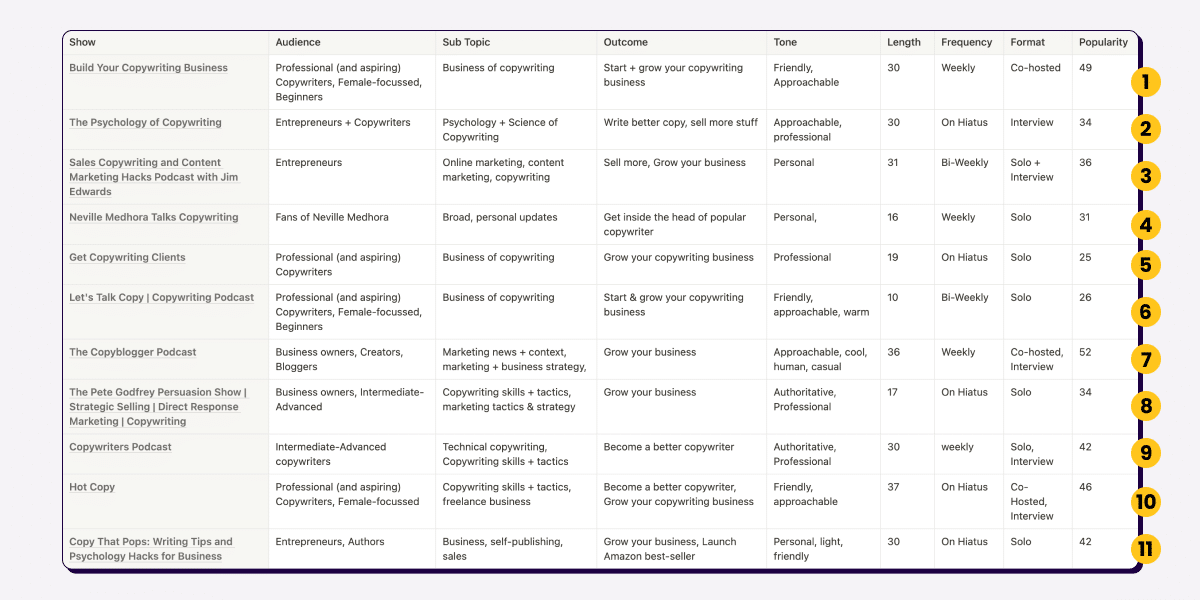Podcast Differentiation Pt 1: Sharpening Your Idea
This lesson will teach you how to focus an idea around a unifying concept to cut through the noise and attract more listeners.
Most Podcast Ideas Are Dull
There are countless great ideas being hatched every single day.
The vast majority of them, however, whether they’re about a potential business, product, book, blog, or podcast will never gain traction and gain awareness.
The reason is that most ideas—even objectively great ones—are too “dull” in their original form to pierce through the incessant, unfiltered noise their target audience is engulfed in.
For a show to have a chance at growth, the idea behind it needs to be honed, refined, and sharpened.
The goal of this sharpening is to reach the point where a potential listener instantly understands and is hooked by the show the moment they come across it.
In this article, we’ll explore the steps involved in sharpening an idea into a show concept that grabs listeners’ attention and doesn’t let it go.
But first, let’s take a look at dull ideas, the place most show ideas start at, and many never leave.
Characteristics of Dull Ideas
The vast majority of podcasts available today are dull ideas.
They cover broad topics, for a broad audience, often with little (or no) editing or production value.
This dullness is one of the primary reasons the majority of shows receive fewer than 29 downloads in their first week after release.
To demonstrate the difference between dull and sharp show ideas, let’s look at some examples.
Dull: A show interviewing the top tennis players in the world about how they got where they are today
🆚
Sharp: A show interviewing the top 100 tennis players in the world, where in every episode, we break down the story behind their one, career-defining shot.
Dull: A show about how to grow a successful business as a freelance copywriter.
🆚
Sharp: A show for freelance B2B tech copywriters about how to increase sales page conversion rates by understanding human psychology.
Dull: A show about music, discussing the latest popular album releases.
🆚
Sharp: A show where each season breaks down a single album with each episode devoted to a single episode on that album.
As you can see, the difference between the dull show and sharp show concepts is stark.
While the sharp ideas are certainly more narrow in their potential audience, for anyone in the target audience who comes across one of the shows, it would be immediately clear that this show is worth their consideration, if not immediate subscription.
So, how do we take a dull idea and sharpen it?
Niche Mapping
The first step to sharpening a show idea is to survey the broader landscape in which it exists.
If you want to stand out, you need to know what you’re competing with for attention.
Start by mapping out the broader niche, industry, or genre your idea lives in.
For example, the copywriting show idea above lives within the larger categories of Business & Entrepreneurship, Creativity, Writing, and perhaps others.
Understanding the larger context your show exists within helps you decide which aspect of it you want to focus on.
It also helps you identify relevant adjacent audiences to target with your marketing efforts.
Once you’ve identified the larger categories your show idea exists within, it’s time to zoom into your specific category using the following exercise.
Exercise
- List all the groups of people who might have some interest in your topic (ie. Freelancers, entrepreneurs, in-house copywriters, copywriting agencies, creative agencies)
- For each group of people, list:
- Specific sub-niches that they might fall into (ie. B2B, B2C, DTC, e-commerce, email copywriters, sales page copywriters, social media copywriters)
- Potential outcomes they may be hoping to achieve by engaging with a show on the topic (ie. Improve copywriting abilities, advance career, get more clients, charge more)
- Specific developmental milestones related to their desired outcomes (ie. Getting their first client, transitioning from freelancer to agency, scaling their agency, selling their agency)
- Search for your topic in your podcast app of choice and make a spreadsheet of every show.
- Make note of the specific audience they target and the outcome they promise
- If they don’t appear to target a specific audience or promise a specific outcome, label each column as “generic”.
- Use a tool like ListenNotes to gauge the show’s relative popularity
- If you have an existing show, add your show to the list and fill in the fields
An analysis of various copywriting podcasts would look something like this.

By the time you’ve completed this exercise, you should have a comprehensive understanding of the podcast landscape your idea exists in.
The next step is to refine your show’s unique positioning within that landscape.
Positioning Your Show
Positioning is about staking out a defined area in your niche that your show can own and can defend.
In most niches, this is actually fairly easy, as the largest grouping of shows will be targeted at dull, generic audiences promising to solve dull, generic problems.
In such cases, all you need to do to create a sharp, ultra-attractive show (for a specific group of people) is decide which area of niche landscape you want to commit to serving better than anyone else.
There are a few ways to do so.
1. Position Your Show By Topic or Audience
The most straightforward way to sharpen your podcast idea through positioning is to narrow the scope of your idea down further than anyone else has yet.
This narrowing of focus can be applied to both:
- Your Topic
- Your Target Audience
Depending on the competition within your niche, you may choose to narrow your focus in either or both of these areas.
Regardless, the goal is to narrow your show’s focus down to the point where it is unmistakably clear to a member of your target audience that your show is the single most relevant show to them.
💡 Example
Base Topic: A show about copywriting.
Narrow Topic: A podcast helping copywriters increase conversions by understanding human psychology.
Narrow Audience: A podcast helping freelance B2B tech copywriters advance their careers.
Both: A podcast for freelance B2B tech copywriters about how to increase sales page conversion rates by understanding human psychology.
This technique is often most necessary and effective for educational or informational shows, where an extreme level of focus can often result in the host quickly becoming seen as the single, world-leading authority on their very narrow topic.
Provided you’re operating in a niche where your specific variety of narrow expertise is valuable, even a tiny niche audience can end up being lucrative.
That said, narrowing the scope of your idea is never a bad idea, even if your show is neither education- nor informational-based.
💡 Example
Base Topic: A comedy podcast.
Narrow Topic: A podcast documenting a comedian’s quest to gain membership in MENSA.
Narrow Audience: A podcast for stay-at-home dads sharing the utterly thankless, entirely rewarding, occasionally funny, always existentially terrifying experience of raising tiny humans while retaining your sense of masculinity.
Idea Excavation
In many cases, the clue to sharpening your show is hiding within your existing show content.
Sometimes, that means dedicating the entire focus of your show to a topic most other shows in your niche would only spend a single episode on.
Where some music podcasts might spend a single episode discussing an album, Dissect, has become one of the most popular podcasts in the world by dedicating each of its seasons to breaking down one album in depth.
Other times, the sharpness (and ideal focus for the entire show) is hiding in a single question you ask your guests that always elicits a fascinating response.
Flops, a podcast by Smart Passive Income created an entire show around a common question in many business shows: “What’s something you failed at and what did you learn?”
While many topics may appear bland, shallow, or one-dimensional from a distance, when you zoom in close enough, you almost always find a rich, nuanced (and often untouched) world waiting to be explored and discovered.
Exercise
- Go through your back catalogue of episodes and identify:
- Any episodes (or clusters of episodes around a specific topic) that:
- Resonated particularly strongly with your audience
- Resonated particularly strongly with you
- Any questions you’ve asked your guests that always seem to lead to fascinating conversations and insights
- Any episodes (or clusters of episodes around a specific topic) that:
- Consider what it would look like to build your entire show around these narrow topics or questions.
Narrowing your focus is the most logical straightforward way to stake out a clear, attractive position in your niche which you can become known for.
But you can also use positioning to make a more broadly focused show stand out as the clear choice for a specific segment of your niche.
2. Position Your Show By Another Variable That Matters To Your Audience
After completing the Niche Mapping exercise, you’ll have compiled a bunch of data about the other shows in your niche.
By organizing this data and displaying it on a chart, you should be able to spot trends and opportunities to stand out.
Here’s how to do it:
Exercise
- Pick two distinct sets of opposing variables that your ideal listeners might use to decide which show to listen to
- Note: The variables should be opposing, but neither should be inherently “good” or “bad”. Each variable should appeal to a certain type of person.
- Example variables include:
- Short episodes vs long episodes
- Beginner vs advanced content
- Broad vs narrow content
- Warm & welcoming tone vs direct & antagonistic tone
- Frequent publish frequency vs infrequent publish frequency
- Etc (there are dozens of variables you might choose to group shows by, many of which might be unique to your niche)
- Create an x-y graph (see example below) with one set of opposing variables on the x-axis and the other set of variables on the y-axis
- Plot the various shows in your niche (including yours) on the graph based on the two sets of variables
- Make note of any obvious gaps in the market
- Repeat with different sets of variables to identify more potential gaps
Continuing with our copywriting example above, here’s what a completed positioning chart might look like for shows targeting entrepreneurs & business owners looking to learn more about copywriting.
Here’s how I decided on the two sets of variables I used in this example:
- In the niche mapping exercise, I noticed that shows tended to either go deep on specific copywriting skill development or cover more general online business strategy through the lens of copywriting.
- It also became obvious that almost all the shows had a warm, friendly, chatty best-friend tone to them.
- There were one or two shows that felt more direct, but none that had really leaned into adopting a direct, no-BS, straight-to-the-point, perhaps even antagonistic approach to tone and branding.
- That seemed like an intriguing opportunity for differentiation.
Based on this positioning graph, there is a clear and obvious gap in the market when it comes to shows that dig into highly tactical copywriting skills and tactics with a direct, possibly antagonistic tone, à la Everyone Hates Marketers or Liquid Death.
For the right show, this presents a compelling opportunity to stand out and become the single best, most obvious choice for a segment of the copywriting market.
Of course, this is just one potential positioning opportunity.
It’s likely that by choosing different variables and re-plotting the shows based on those alternative variables, we could identify additional opportunities to create a sharp show that is clearly positioned as the go-to choice for a segment of the audience.
Understand What Matters to Your Audience Then Commit
When it comes to your positioning, there are three things to keep in mind:
- Pick one attribute to stake your positioning around.
- That attribute needs to matter to your potential listeners. Said differently, it must be something that would actually cause them to choose your show, even over a bigger, more-popular, better-produced competitor.
- Once you pick your positioning, you need to commit to it. Hard. Everything you do should reinforce your positioning and it should be impossible for a new potential listener not to understand.
💡 Example: Everyone Hates Marketers
- Louis Grenier, the host of Everyone Hates Marketers was sick of boring marketing podcasts that rehashed the same conversations and didn’t leave listeners with anything they could use.
- So he started the show with the goal of providing an alternative.
- His antagonistic, contrarian approach was built into everything from the show’s name, to the branding and cover art, to his extensive cursing, to his aggressive line of questioning.
- He committed to asking guests tough, tactical questions that would risk making guests uncomfortable… but actually gave listeners something actionable to take away.
- As a result, EOHM has racked up more than a million downloads and has become a cult-favorite show among marketers.
Prioritize Early Traction
The more clearly and narrowly defined a show’s positioning is, the easier and faster it will be to both gain initial traction and generate income.
And it’s traction, not mass-appeal, that should be your number one focus.
Early on, your goal is to create a show that is utterly un-ignorable to a very specific audience that will then help you build buzz, engagement, and momentum that will then allow you to naturally expand outward in both audience and topic.
You can’t skip this step.
Global juggernauts like Facebook and Tinder both started as niche apps for users on a single college campus.
Airbnb began as a clunky tool for out-of-town conference attendees to rent air mattresses on a stranger’s floor in San Francisco.
The secret to going big is almost always starting small and sharp.
Crafting Your Hook
In many spaces, clear positioning is often enough to create a compelling reason for listeners to choose your show.
But in more crowded niches, it may not be enough.
In the next lesson, we’ll explore how to make your show even more attractive to potential listeners by developing a unique and compelling concept.
Next Lesson – Differentiation Pt 2: Crafting Your Hook (Coming Soon)
How to make your show un-ignorable.




